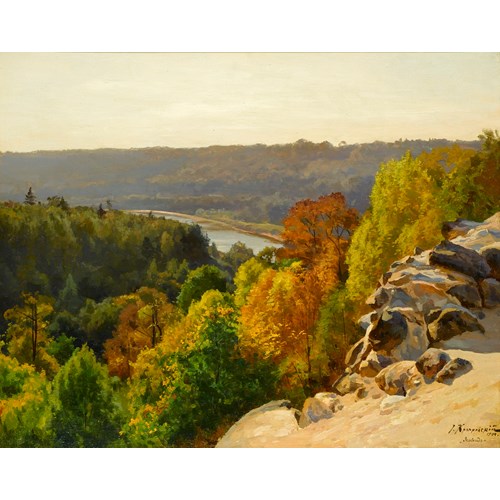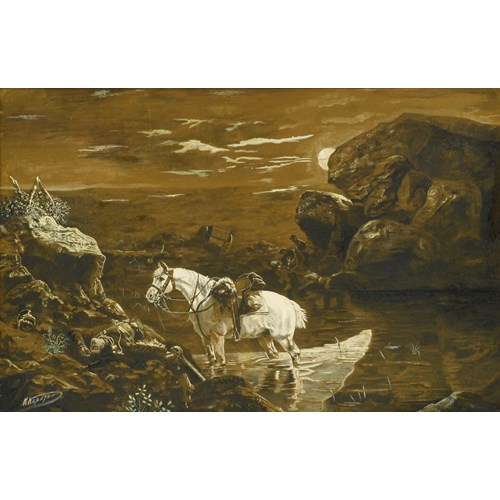Marketplace
Harbour Scene
Mikhail Pelopidovich Lattry
Harbour Scene
Epoque 20th century
Origine Ukraine, France
Medium Pencil, Watercolour, Gouache on paper
Dimension 30 x 36 cm (11³/₄ x 14¹/₈ inches)
In this sunlit mediterranean scene Mikhail Pelopidovich Lattry has depicted an archipelago from an aerial perspective, giving the viewer a wide-ranging view of this idyllic paradise. A series of islands are dotted across the seascape, surrounded by the white crests of breaking waves. The two foreground islands are adorned with picturesque whitewashed buildings, and their golden sands and palm trees entice us in. Along their shores, a number of small fishing boats are moored, and on one of the islands a galleon is being built in a shipyard. There is a strong wind blowing across the seascape filling the ships’ sails, making the flags flutter and buffeting the palm trees.
On the basis of the architecture, it seems possible that Lattry located the scenery of the present watercolour in Greece. Lattry first visited the country in 1897, whilst a student, returning in 1920 to escape the Revolution. Whilst there he directed the Royal Ceramic School in Athens and took part in excavations organised by the French Academy at Delos; his work on ceramics during this period was typified by its stylised design.
Harbour Scene is comparable to many of Lattry’s marine landscapes, such as The Squall, (Private Collection) in which he proves himself extremely inventive and adventurous with viewpoints, perspective and scale. In both works ships are extremely large and out of proportion to the surrounding landscape, land soars violently upwards and buildings lean at slightly bizarre angles. These techniques and features create movement throughout the work and engage the viewer. It was this type of animated interpretation of the landscape which Lattry specialised in.
Lattry’s grandfather was the famed Russian marine artist Ivan Konstantinovich Aivazovsky, and although Lattry’s style is definitively twentieth century, one could argue that the stylised skewed perspective, choice of warm palette, and careful placing of each single element within the scene is a manner of romanticising the seascape, much in the same way as his grandfather deftly used romantic elements within his own compositions. In this way, Lattry appears to align himself with the work of his grandfather, despite his modern style.
Lattry studied landscape painting under A. I. Kuinji (1842-1910) at the Imperial Academy of Arts, St. Petersburg in 1896. The following year he toured Greece, Turkey and Italy before studying in Munich. He returned to St. Petersburg in 1899 where he rejoined the Academy and graduated in 1902. Before his death in 1900, Aivazovsky, who had no sons, had wanted Lattry to adopt his name. Lattry, who was already building up an artistic name for himself, refused and Aivazovsky, used to getting his own way, was furious and initially threatened to disinherit Lattry.
For the next fifteen years Lattry took part in many exhibitions and artistic activities. Between 1912 and 1913, he exhibited at the ‘World of Art’ association in St. Petersburg, Moscow and Kiev, and his paintings were reproduced in magazines including World of Art and Ogonek.
In 1906, Lattry returned to his beloved Baran-Eli estate near Feodosija in the Crimea, which he had inherited, through his mother, from Aivazovsky. He successfully took up farming, but devoted himself mainly to painting as well as ceramics. His decorative ceramics, being transitional between Art Nouveau and Art Deco styles, were of considerable importance, and were shown in Vladimir Isdebsky’s (1882-1965) salon in 1909. Around this time, Lattry became Director of the Aivazovsky Gallery in Feodosija, which his grandfather had bequeathed to the town. He settled in Paris in 1924 where he set up a studio as a charitable enterprise to aid Russian refugees. His later work, from his Paris studio, included his Delos, Mykonos and Piraeus cycles, as well as French country landscapes. Lattry died in Paris in 1942.
On the basis of the architecture, it seems possible that Lattry located the scenery of the present watercolour in Greece. Lattry first visited the country in 1897, whilst a student, returning in 1920 to escape the Revolution. Whilst there he directed the Royal Ceramic School in Athens and took part in excavations organised by the French Academy at Delos; his work on ceramics during this period was typified by its stylised design.
Harbour Scene is comparable to many of Lattry’s marine landscapes, such as The Squall, (Private Collection) in which he proves himself extremely inventive and adventurous with viewpoints, perspective and scale. In both works ships are extremely large and out of proportion to the surrounding landscape, land soars violently upwards and buildings lean at slightly bizarre angles. These techniques and features create movement throughout the work and engage the viewer. It was this type of animated interpretation of the landscape which Lattry specialised in.
Lattry’s grandfather was the famed Russian marine artist Ivan Konstantinovich Aivazovsky, and although Lattry’s style is definitively twentieth century, one could argue that the stylised skewed perspective, choice of warm palette, and careful placing of each single element within the scene is a manner of romanticising the seascape, much in the same way as his grandfather deftly used romantic elements within his own compositions. In this way, Lattry appears to align himself with the work of his grandfather, despite his modern style.
Lattry studied landscape painting under A. I. Kuinji (1842-1910) at the Imperial Academy of Arts, St. Petersburg in 1896. The following year he toured Greece, Turkey and Italy before studying in Munich. He returned to St. Petersburg in 1899 where he rejoined the Academy and graduated in 1902. Before his death in 1900, Aivazovsky, who had no sons, had wanted Lattry to adopt his name. Lattry, who was already building up an artistic name for himself, refused and Aivazovsky, used to getting his own way, was furious and initially threatened to disinherit Lattry.
For the next fifteen years Lattry took part in many exhibitions and artistic activities. Between 1912 and 1913, he exhibited at the ‘World of Art’ association in St. Petersburg, Moscow and Kiev, and his paintings were reproduced in magazines including World of Art and Ogonek.
In 1906, Lattry returned to his beloved Baran-Eli estate near Feodosija in the Crimea, which he had inherited, through his mother, from Aivazovsky. He successfully took up farming, but devoted himself mainly to painting as well as ceramics. His decorative ceramics, being transitional between Art Nouveau and Art Deco styles, were of considerable importance, and were shown in Vladimir Isdebsky’s (1882-1965) salon in 1909. Around this time, Lattry became Director of the Aivazovsky Gallery in Feodosija, which his grandfather had bequeathed to the town. He settled in Paris in 1924 where he set up a studio as a charitable enterprise to aid Russian refugees. His later work, from his Paris studio, included his Delos, Mykonos and Piraeus cycles, as well as French country landscapes. Lattry died in Paris in 1942.
Epoque: 20th century
Origine: Ukraine, France
Medium: Pencil, Watercolour, Gouache on paper
Signature: Signed ‘M Lattry’ (lower right).
Dimension: 30 x 36 cm (11³/₄ x 14¹/₈ inches)
Plus d'œuvres d'art de la Galerie









